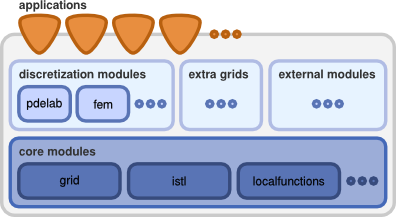DuMux
DuMux - DUNE for Multi-{Phase, Component, Scale, Physics, …} flow and transport in porous media and more. The swiss army knife of porous media research. Open-source simulator in modern C++.
DUNE, the Distributed and Unified Numerics Environment, is a modular toolbox for solving partial differential equations (PDEs) with grid-based methods. It supports the easy, flexible, and efficient implementation of finite element and volume methods. DUNE is C++ code and also has a Python interface.
DUNE, the Distributed and Unified Numerics Environment is a modular toolbox for solving partial differential equations (PDEs) with grid-based methods. It supports the easy, flexible, and efficient implementation of finite element and finite volume methods. DUNE is written in C++, but has interfaces to Python as well.

The underlying idea of DUNE is to create slim interfaces that allow the efficient use of legacy and/or new libraries. Modern C++ programming techniques enable very different implementations of the same concept using a common interface at a very low overhead. Thus, DUNE ensures efficiency in scientific computations and supports high-performance computing applications.
Particular highlights are:
DUNE is free software licensed under the GPL (version 2) with a so-called "runtime exception" (see license). This licence is similar to the one under which the libstdc++ libraries are distributed. Thus, it is possible to use
DUNE even in proprietary software.
Separation of data structures and algorithms by abstract interfaces: This provides more functionality with less code and also ensures maintainability and extendability of the framework.
Efficient implementation of these interfaces using generic programming techniques: Static polymorphism allows the compiler to do more optimizations, particularly function inlining, allowing the interface to have very small functions (implemented by one or few machine instructions) without a severe performance penalty. In essence, the algorithms are parametrized with a particular data structure, and the interface is removed at compile time. Thus the resulting code is as efficient as if it would have been written for the special case.
Reuse of existing finite element packages with a large body of functionality: In particular, the finite element codes UG, ALBERTA, and ALUGrid have been adapted to the DUNE framework. Thus, parallel and adaptive meshes with multiple element types and refinement rules are available. All these packages can be linked together in one executable.
The framework consists of several modules, which are downloadable as separate packages. There is a set of
core modules used by most other packages. The dune-grid core module already contains some grid implementation, and further grid managers are available as extra modules.
Main discretization modules provide the infrastructure for solving partial differential equations
using DUNE, and are available as separate modules. The modular structure of DUNE allows for using a small set of the modules (e.g., only the solver module dune-istl or the module dune-localfunctions containing shape functions without, for example, using the dune-grid or a full discretization module).
For further information, see the main features, read the documentation for application writers, or get in touch with the people actively developing DUNE.

DuMux - DUNE for Multi-{Phase, Component, Scale, Physics, …} flow and transport in porous media and more. The swiss army knife of porous media research. Open-source simulator in modern C++.